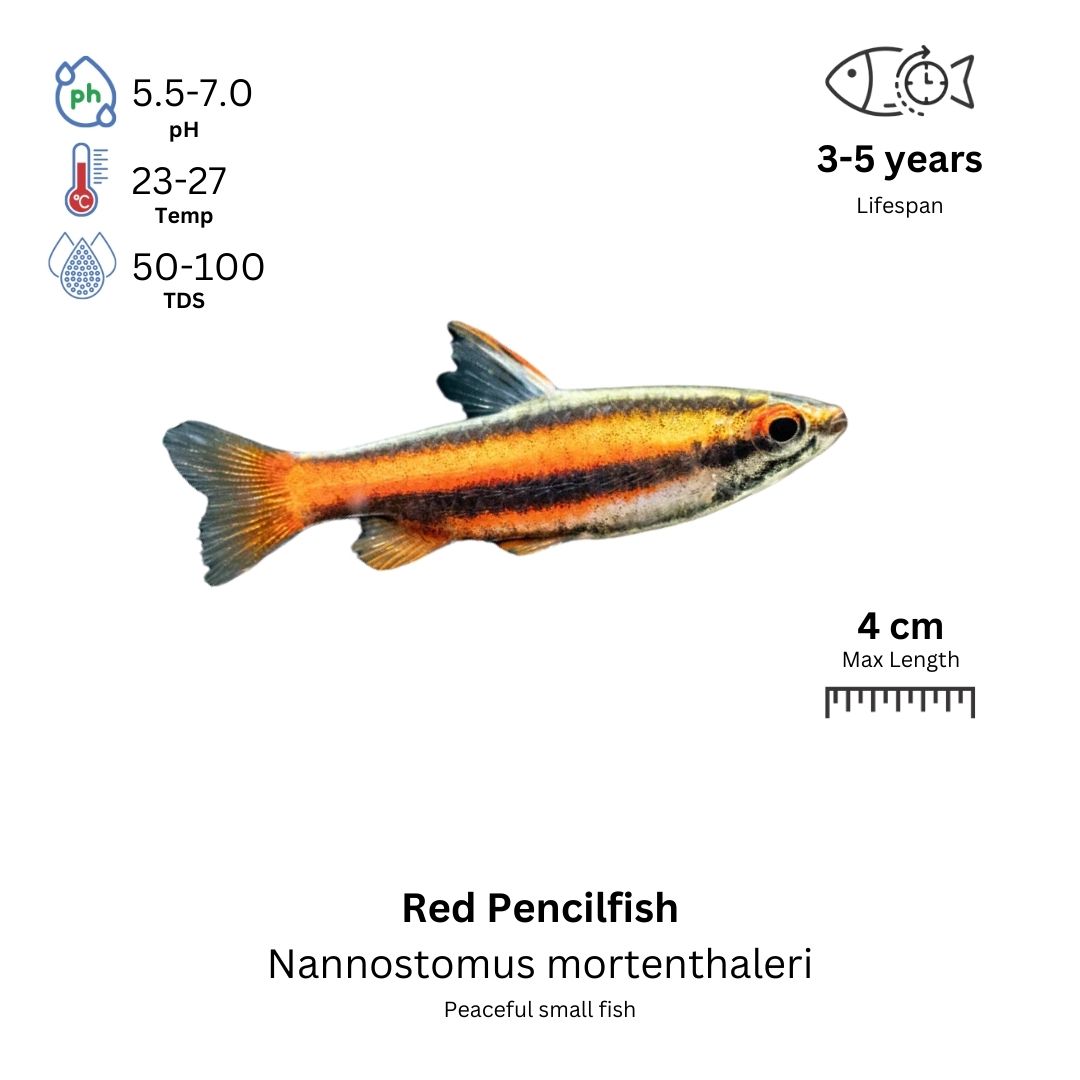Red Pencilfish: A Striking and Peaceful Nano Fish
Introduction
The Red Pencilfish (Nannostomus mortenthaleri), also known as the Purple Pencilfish or Coral Red Pencilfish, is a stunning freshwater fish admired for its vivid red coloration, elongated body, and peaceful nature. This nano fish is a favorite among aquascapers due to its small size, schooling behavior, and compatibility with planted aquariums.
Though slightly more delicate than some other small fish, Red Pencilfish reward careful keepers with their brilliant color and active swimming habits.
Characteristics
- Scientific Name: Nannostomus mortenthaleri
- Common Names: Red Pencilfish, Coral Red Pencilfish, Purple Pencilfish
- Family: Lebiasinidae
- Size: 1.5–2 inches (4–5 cm)
- Lifespan: 3–5 years
- Behavior: Peaceful, schooling fish
- Care Level: Moderate (requires stable water conditions)
Origin and Distribution
Red Pencilfish originate from Peru, specifically in the Amazonian tributaries of the Nanay and Tigre Rivers. These fish are found in slow-moving blackwater streams, where the water is soft, acidic, and rich in tannins from decomposing leaves. Their natural environment is heavily planted with submerged vegetation, offering plenty of hiding spots.
💡 Tip: Mimicking their blackwater habitat with driftwood and leaf litter helps them feel at home and enhances their red coloration.
Colors and Markings
Red Pencilfish are among the most colorful pencilfish species, featuring:
- 🔴 Bright red to deep crimson bodies, intensified with proper care.
- ⚫ Thin black horizontal stripes, extending from the snout to the tail.
- 🟠 Yellow-orange accents, especially in dominant males.
- 🔥 Iridescent hues under the right lighting conditions.
Color Differences Between Genders
- Males have brighter red coloration and a more defined black stripe along the body.
- Females are slightly larger, less intensely colored, and may appear more translucent.
Tankmates
Red Pencilfish are peaceful and best kept in schools of 6 or more, which helps reduce stress and enhance their natural behaviors. They thrive in planted community aquariums with small, non-aggressive fish.
✅ Compatible Tankmates:
- Small Tetras (Neon, Ember, Green Neon)
- Rasboras (Chili Rasbora, Harlequin, Lambchop)
- Corydoras Catfish (Pygmy, Panda, Sterbai)
- Gouramis (Sparkling, Honey)
- Otocinclus Catfish
- Shrimp and Snails (Amano Shrimp, Cherry Shrimp, Nerite Snails)
🚫 Avoid:
- Fin-nipping species (Tiger Barbs, Serpae Tetras).
- Aggressive fish (Cichlids, Bettas).
- Large, fast-moving fish that may outcompete them for food.
Care Requirements
Maintaining stable water parameters is crucial for keeping Red Pencilfish healthy and vibrant.
Tank Setup:
- Tank Size: Minimum 15 gallons for a school.
- Water Temperature: 24–28°C (75–82°F).
- pH Level: 5.0–7.0 (slightly acidic to neutral).
- Water Hardness: 1–8 dGH (soft water preferred).
- Filtration: Gentle sponge or canister filter (low flow preferred).
- Lighting: Dim to moderate (enhances their natural colors).
- Aquarium Setup:
✔ Live plants (Java Fern, Anubias, Amazon Sword).
✔ Driftwood & Indian Almond Leaves to mimic blackwater conditions.
✔ Dark substrate to enhance their red coloration.
🚨 Tip: Red Pencilfish thrive in low-stress environments, so avoid bright lighting and strong currents.
Diet and Feeding
Red Pencilfish are micro-predators, meaning they thrive on a protein-rich diet of small live or frozen foods.
Best Foods:
✔ High-quality micro-pellets or flakes (protein-rich).
✔ Live or frozen foods (baby brine shrimp, daphnia, bloodworms).
✔ Insect-based foods (freeze-dried tubifex, mosquito larvae).
Feed small portions 2–3 times daily to maintain their energy and coloration.
💡 Tip: A diet rich in carotenoids (found in brine shrimp and spirulina-based foods) enhances their red hues.
Gender Differences
- Males have intense red colors and more defined black stripes.
- Females are larger, rounder, and slightly paler in comparison.
- During breeding season, males intensify their colors and perform courtship displays.
Breeding Red Pencilfish
Red Pencilfish can be challenging to breed, but with the right conditions, they will naturally spawn in a well-planted tank.
Breeding Process:
- Separate Breeding Tank: Use a soft, acidic water setup with a temperature of 26–28°C (78–82°F).
- Fine-Leaved Plants: Add Java Moss or spawning mops for egg-laying.
- Courtship & Spawning: Males chase females, who lay small adhesive eggs among plants.
- Hatching & Fry Care:
- Eggs hatch in 24–36 hours.
- Fry are free-swimming within 3–5 days.
- Feed fry infusoria or powdered fry food, followed by baby brine shrimp.
🚸 Tip: Remove adult fish after spawning to prevent them from eating the eggs.
Common Health Issues & Solutions
🔴 Ich (White Spot Disease):
✔ Solution: Increase temperature to 28°C (82°F) and use anti-parasitic treatments.
🔴 Fungal Infections (White Patches on Skin):
✔ Solution: Improve water quality and use mild antifungal medications.
🔴 Stress-Related Issues (Color Fading, Hiding, Not Eating):
✔ Solution: Ensure stable water parameters, a proper diet, and a peaceful tank environment.
🚨 Tip: Frequent small water changes (20% weekly) prevent most health issues.
Additional Resources
For more fish care guides, check out:
- Best Nano Fish for Planted Aquariums
- How to Maintain a Blackwater Aquarium for Softwater Fish
- Breeding Pencilfish: A Step-by-Step Guide
Conclusion
The Red Pencilfish is a stunning, peaceful, and unique schooling fish, perfect for planted aquariums and blackwater setups. Their brilliant red coloration, active swimming behavior, and fascinating breeding habits make them a top choice for nano tank enthusiasts and aquascapers.


Reviews
There are no reviews yet.